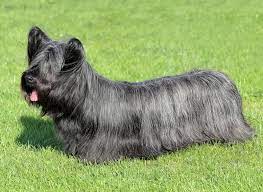Your Skye’s grooming needs will depend upon how much time he or she spends outdoors. If your Skye spends a lot of time outside in your yard digging and chasing, then daily combing is a must. Use a metal comb with long teeth that can get to the roots of your pet’s double coat, and be on the lookout for fleas, ticks, tangles, and mats. If your Skye mostly hangs out on your couch, then weekly combing may be all you need. Keep in mind, though, that Skye terriers are not hypoallergenic. They shed a moderate amount, and the more often you brush them, the less hair will get on your furniture, rugs, and carpets.
Table of Contents
What does Hypoallergenic Mean?
Do Skye Terriers shed?
Compared to other Terriers, I’d say the Skye Terrier sheds more. That’s because many Terriers, the Lakeland Terrier among them, have wiry fur while the Skye Terrier doesn’t. Wiry, coarse fur tends to shed less frequently.
Are Skye Terriers good apartment dogs?
The Skye Terrier is most comfortable living indoors as a house dog. However, it should be allowed outside to play daily. Also, to maintain its peak physical form, a daily short or moderate walk is required. Coat care involves regular combing, and unlike other terriers, a regular bath is necessary and won’t soften the coat much.
Do Skye Terriers Cause Allergies?
5. West Highland White Terrier. The “Westie” is not only known for its friendly and strong-willed personality, but also for the minimal shedding of its dense and wiry coat. The West Highland White Terrier’s coat also helps retain the little allergy-causing dander it produces.
How to prevent allergies
Groom your Skye Terrier
The Cairn Terrier should do well on high-quality dog food, whether commercially manufactured or home-prepared with your veterinarians supervision and approval. Any diet should be appropriate for dogs age. Some dogs are prone to getting overweight, so watch your dogs ‘ calorie consumption and weight level. Treats can be an important aid in training, but giving too many can cause obesity. Learn about which human foods are safe for dogs, and which are not. Check with your vet if you have any concerns about your dog’s weight or diet. Clean, fresh water should be available at all times. Cairn Terriers are generally easy keepers, although weekly brushing and combing are recommend, as well as periodic hand-stripping to maintain coat texture. Having a comb and soft slicker brush handy will help with grooming tasks. With a new puppy, spending time together in grooming sessions helps to accustom him or her to being work with and is an opportunity to develop a bond between you. Nails should be trim regularly, as overly long nails can cause dog discomfort. Cairns requires a moderate amount of exercise and can adapt well to various living situations when giving daily outings. They can thrive anywhere from Highlands farm to urban high-rise and are excellent all-around dogs. Training for dog sports provides an ideal outlet for their energy. Breed exercise body and mind by participating in obedience, tracking, herding, agility, Earthdog events, coursing ability tests, and other activities that dog and owner can enjoy together. Cairn is one of several terrier breeds, some still extant, others now extinct, who for centuries patrolled game preserves and farms of Scotland. Unravelling the histories of these breeds is difficult because for so many years they were lumped together as simply Scotch Terriers. Not until the late 1800s do breed fanciers devise strict breeding programs and classifications for this hardy family of exterminators. The name Cairn Terrier did not appear in print until 1887, though by then Cairn-type Terrier had been around for a long time. Cairns were known from at least 1600s to dwell in the Western Highlands, most notably on the Isle of Skye, birthplace of their kinsman Skye Terrier. Once upon a time in Scotland, mound of stones used as boundary or to mark graves was called Cairn. On highland game preserves, rodents would live within and beneath these rock piles. The Cairn Terrier, among the smallest of go-to-ground terriers, was developed to dig into Cairns and rout out critters. When grouped in packs, these plucky little hunters also work on foxes, otters, and other predators. Cairns ‘ independence, courage, toughness, and alertness were qualities that serve them well when digging into Cairn alone and confronting sharp-toothed mammals. By turn of the 20th century, British Terrier fanciers had sorted out various Scotch earthdogs and begun breeding Cairn, Scottish, Skye, and West Highland White Terriers as distinct pure breeds.
Cleaning
The Skye Terrier is a hunting dog and enjoys a daily outing, exploring in a safe area. It also needs a short to moderate walk with its owner to stay in shape. The Skye enjoys life as a housedog, and prefers not to live outdoors. So, owners should not keep them outdoors as their natural habitats. Regular combing (about twice a week) is all that is needed to keep the Skye looking well and detangled. Many owners think that an occasional bath will soften the coat, as is often the case with other terriers, but that is not the case. An occasional bath will not soften the coat too much. Owners must pay attention to the area around their eyes and mouth; this may need frequent cleaning.
Coat
It is believed Mary Queen of Scots had a Skye Terrier. He stayed with her until the very end, hiding under her petticoat whilst she was executed, proving this breeds undeniable loyalty.


Hello, I enjoy reading through your post. I wanted to write a
little comment to support you.
Hi Florencia,
Thank you very much for the feedback. It is greatly appreciated.